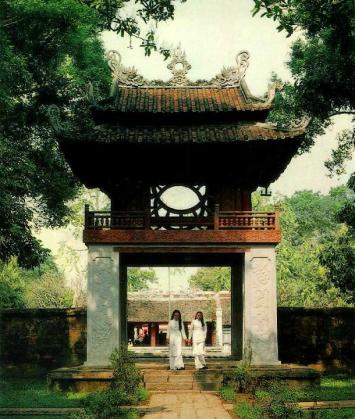Located in the Dong Da section of Hanoi, Van Mieu, or the Temple of Literature, is the oldest school in Vietnam, giving it the distinction of being the most significant temple in both Hanoi and Vietnam. It is representative of Confucian ways of thought and behavior, and is a historical and cultural relic.

According to historical records, during the 8th lunar month of the Canh Tuat Year (1070), King Ly Thanh Tong erected several important monuments, including the Temple of Literature and the carvings of Confucius, Chu Cong, four disciples, and 72 other scholars who were considered to be model Confucians. Ceremonies were dedicated to them once every season of the year. The Crown Prince has traditionally been educated here. In 1076, Vietnam’s first university, Quoc Tu (National University), was established under the direction of King Ly Nhan Tong near Van Mieu for the purpose of instructing the children of Mandarins, the aristocrats, and the brightest commoners. During its more than 700 years of instruction (1076-1779), Quoc Tu Giam educated thousands of talented men for Vietnam. Among the most notable are the mathematician Luong The Vinh, the historian Ngo Sy Lien, the encyclopedist Ly Don, and the politician-diplomat Ngo Thi Nham.
After more than 900 years of existence, repairs and renovations, Quoc Tu Giam is still an example of well-preserved traditional Vietnamese architecture. Also preserved within these confines are valued relics representing the Millenary civilization, such as stelae with inscriptions of the names of distinguished scholars, the Well of Heavenly Clarity (Thien Quang Tinh), the pavilion in dedication of the Constellation of Literature (Khue Van Cac), the statue of Confucius, the Great House of Ceremonies, the ancient wall, kowtow portico and the sanctuary, the stone dragons, and the ink stone stands. Secular trees, such as the banyan and frangipani, were present during literary meetings, festivals and examinations that occurred during the Ly, Tran and Le dynasties. They continue to flourish.
Particularly impressive is the collection of 82 stone stelae which rest upon large stone tortoises. They were created between 1484 and 1780 and are engraved with the names, places of birth and achievements of the 1,306 doctor laureates that received their degrees during this time span. These stelae were erected to encourage learning and bestow honor on the talented men who assisted the Kings in defending the country.
An important historical and cultural vestige of Vietnam, Van Mieu and Quoc Tu Giam are currently under repair to restore their original appearance.
The land of Quang Binh is favored by nature, possessing a large, pristine system of both large and small caves, which...
The phrase “Mekong River – A Buddhist River” describes the cultural heritage of Buddhism in the...
The Independence Palace has been existing for 154 years; however, the Independence Palace you see today was erected in...
The resort is located 80 kms North of Nha Trang at the tip of an archipelago. It is absolute paradise – an ideal...
Being is one of the well-known beaches in the north of Vietnam, Do Son is a small peninsular formed by the stretch of...
Ca Na beach On the map of Vietnam tourism as well as the world’s, Ca Na is amongst the impressive names for a...
Entrance to the Cham Museum Situated in a quiet area of Da Nang City, Cham Museum was built in 1915 according to the...
Phu Quy Island, whose name means “rich and precious,” lies about 100 km to the east of Phan Thiet City;...